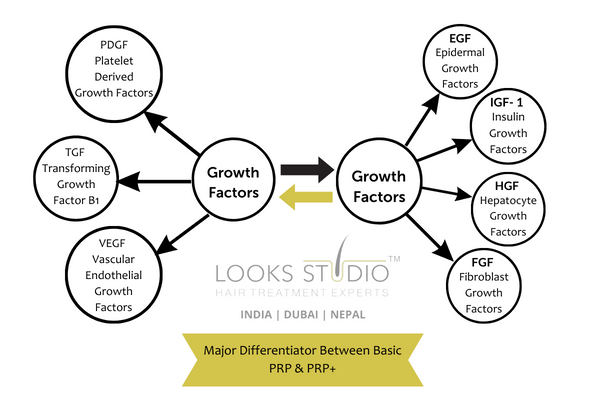PRP + has also become popular in hair restoration procedures, particularly when combined
with Bio-Integrated FUE. The autologous, minimally invasive treatment modality has been
shown to encourage hair growth by promoting cellular maturation, differentiation, and
proliferation while minimizing the risk of infection and immune rejection.
“There are several different devices available for PRP techniques. Some activate platelets before
the PRP is injected which is the modern PRP + technique with 7 growth factors while others are
associated with the activation of platelets with injection.

When performing Bio-Integrated FUE, a novel approach is to perform the PRP + technique
intraoperative, injecting the solution before placing the grafts in the front is also a way of pre-activation
of growth cells. Clinically, this will help maintain the existing hair around the
transplant sites and aid in making the transplanted grafts grow a little sooner.
It appears that PRP + boosts the hair cycle, allowing patients to arrive at their desired outcomes
sooner. It has even been shown to be effective in treating scarring alopecias, also.
“The PRP + is a way to combine Bio-Integration or special graft preservation method with
medical techniques. “ When performed intraoperatively, PRP + gives a boost to the transplanted
hair and also treats and helps to maintain the already existing but thinning hair.”
Male vs Female pattern baldness :
Male pattern baldness evolves from the age of 18-19 causing a Male pattern-shaped receding
or thinning and hair-line and crown part hair follicles loss which over a period of time becomes
bigger and leads to the advanced stage of Androgenetic alopecia. Females also experience hair-line
corners hair-loss and profuse thinning on the forelock zone. Since DHT level formations in
women are comparatively low than in men, women don’t go completely bald like men. But men
and women need hair restoration and follicle replacement methods both in terms of saving
their existing hair and also adding follicles on the balding areas.
Progressive hair loss is common in both men and women. The most common type of hair loss is
known as androgenetic alopecia. Other terms for androgenetic alopecia include ” male pattern
hair loss” and ” female pattern hair loss.”
For many people, losing their hair is a frustrating experience. Fortunately, treatments are
available that can help to regrow hair or prevent further hair loss.
Causes :
The hair follicle is a structure that encases the lower part of the hair shaft (the shaft is the part
you can see outside your scalp). Each follicle contains blood vessels that nurture new hair
growth. All hair follicles are present at birth; throughout a person’s lifetime, each follicle grows
and sheds single hair in a repetitive cycle. The growth phase for a single new hair lasts two to
three years. At the end of this time, growth ceases and the follicle enters a resting phase. After
three to four months in the resting phase, the hair is shed and the next growth cycle begins.
On a normal scalp, approximately 80 to 90 per cent of follicles are growing at any time. Each day,
about 75 follicles shed their hair while the same number enter a new growth phase. In men with
androgenetic alopecia, hormones related to testosterone (also called androgens) cause hair
follicles to have a shorter-than-normal growth phase, resulting in hair shafts that are abnormally
short and thin. These follicles are said to be ” miniaturized.” This also happens in women with
androgenetic alopecia, although it’s less well understood exactly what factors contribute to this
process.
Genetics:
It is not fully understood why some men develop androgenetic alopecia and others do not. It is
generally accepted that there is a genetic component, but the exact way in which family history
affects a man’s chance of developing hair loss has not been determined.
Genetics also appear to play a role in the risk for androgenetic alopecia in women, although
other factors (some of which remain unknown) may also be important. As an example,
abnormal levels of androgens in the blood are the cause of androgenetic alopecia in a minority
of women. Additional research is necessary to better understand the role of
genetics and other factors in androgenetic alopecia.
Symptoms:
In men, androgenetic alopecia is characterized by gradual hair thinning that most often affects
the crown and frontal areas of the scalp.
Hair loss in women usually affects the crown and frontal areas of the scalp. Typically, the hair
loss is more diffuse than in men; women rarely develop entirely bald areas.
Diagnosis :
Androgenetic alopecia can usually be diagnosed by examining the scalp. In some cases, you will
need blood tests or a biopsy of the scalp to look for other causes of hair loss.
Psychosocial impact of hair loss :
Losing your hair can be frustrating and upsetting. While it’s normal and common to lose hair
with age, it can still be distressing, as people often feel that society reinforces the
message that a youthful appearance is more attractive. People with hair loss may struggle with
low self-esteem or body image issues.
If you are struggling with the psychosocial impact of losing your hair, speak to a healthcare
provider knowledgeable about the diagnosis and treatment of hair loss. Experienced providers
can offer support and may recommend working with a therapist, clinical psychologist, or
support group; individual and group therapy can help people adjust and cope with hair loss.
Having a supportive partner, family members, or friends can also help.
Some people choose to accept their hair loss and learn to live with it, while others choose
treatment.
Follicle replacement options Bio-Integrated FUE, and injections of platelet-rich plasma + may
also, be considered in some cases.


 . Now
. Now